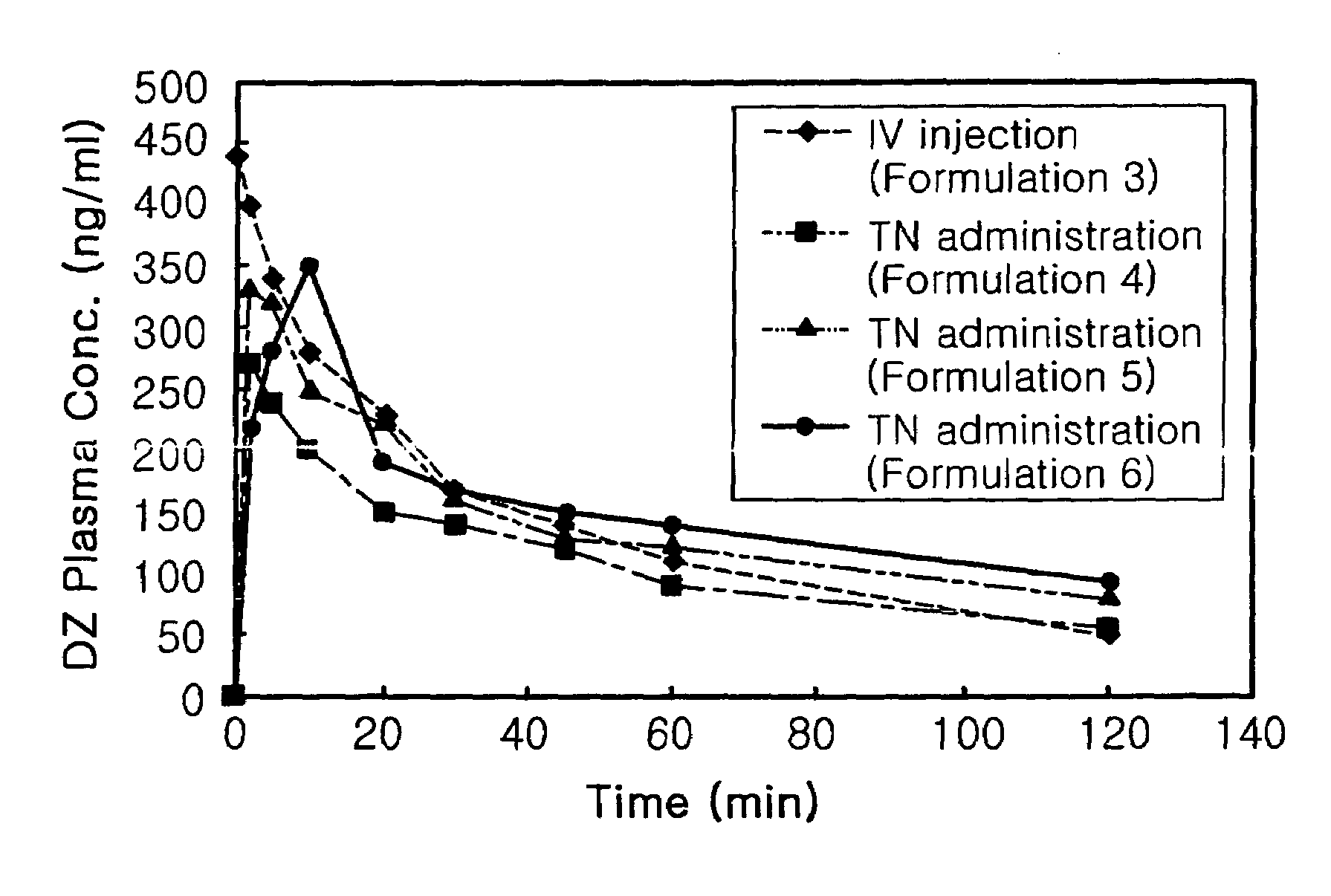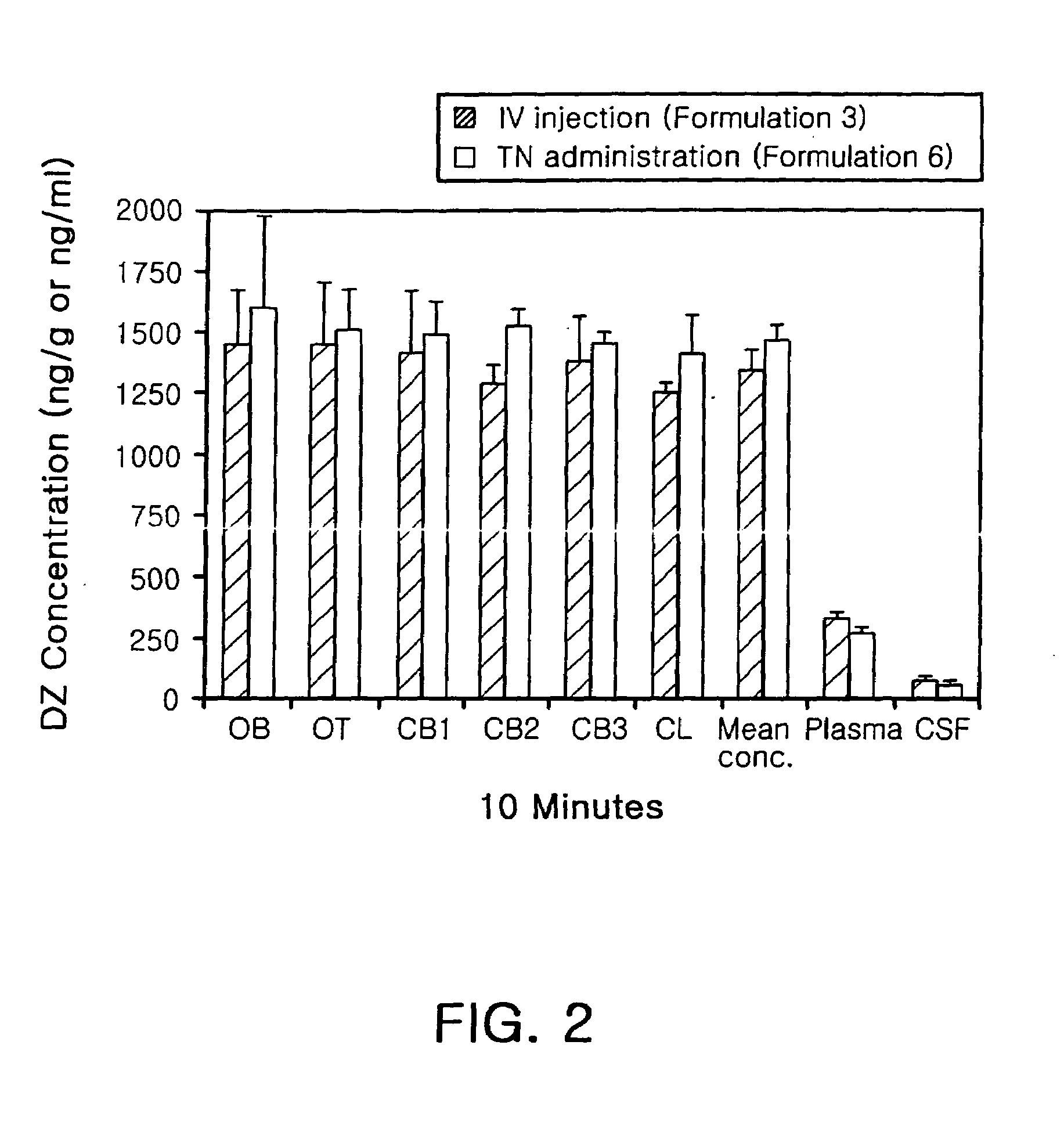Transnasal anticonvulsive pharmaceutical composition
a technology of transnasal and composition, which is applied in the direction of drug compositions, biocide, muscular disorders, etc., can solve the problems of inconvenient rectal route drug administration, inability to achieve the desired level of therapeutic agent by means of simple transnasal administration
- Summary
- Abstract
- Description
- Claims
- Application Information
AI Technical Summary
Benefits of technology
Problems solved by technology
Method used
Image
Examples
example 1
In Vitro Nasal Mucous Membrane Permeation Study
[0028]The nasal mucous membrane used in the in vitro experiment was obtained from New Zealand White rabbits, weighing 2.5 to 3.0 kg. Rabbits were sacrificed by intravenous (IV) injection of pentobarbital sodium. The nasal septum was carefully removed from a bone block using surgical scissors and a bone-cutting saw. Two pieces of the nasal mucous membrane were then carefully stripped from the nasal septum without touching the center of the membrane surface and washed with a normal saline solution. The mucous membrane was mounted between two half-cells of a glass diffusion cell system. The exposed area of the nasal mucous membrane was approximately 0.196 cm2. A test solution or suspension (3.5 mL) was introduced into the mucosal side of the membrane in the donor compartment while 3.5 mL of a mixture of 10% ethanol, 40% propylene glycol and 50% isotonic phosphate buffer solution (pH 7.4) was added to the receptor compartment. The entire di...
example 2
Preparation of Diazepam Formulations
[0031]For comparison of transmucosal permeability of a drug in rabbits, the transnasal preparation disclosed in U.S. Pat. No. 6,627,211 (Formulation 1) and a microemulsion preparation using a vehicle system of the present invention (Formulation 2) were prepared. Both preparations were formulated to contain an equal weight of diazepam. For a transmucosal permeation experiment, the diazepam preparation of U.S. Pat. No. 6,627,211 was prepared by adding 1% sodium glycocholate to a co-solvent vehicle consisting of 30% ethanol (ETOH), 60% propylene glycol (PG) and 10% water (WT), followed by addition of 1% diazepam (Formulation 1). A preparation containing 1% diazepam was prepared using a microemulsion vehicle system (see Table 1) of the present invention (Formulation 2). As caprylocaproyl macrogol-8-glycerides, Labrasol (available from Gattefosse, Westwood, N.J., USA) was used. As diethyl glycol monoethyl ether, Transcutol P (available from Gattefosse,...
example 3
[0032]This example is intended for the in vitro permeation study of diazepam through the freshly excised nasal membrane. In this study, the transmucosal permeability was compared between Formulation 1 for transnasal administration proposed in U.S. Pat. No. 6,627,211 as described above and Formulation 2 according to the present invention.
TABLE 2Transmucosal permeability of transnasal formulationsFormulationsPermeability Jss (μg / cm2 / hr)Formulation 1 (U.S. Pat. No. 6,627,211)89.7 ± 10.1Formulation 2 (Vehicle of Invention)196.6 ± 4.9
PUM
| Property | Measurement | Unit |
|---|---|---|
| concentration | aaaaa | aaaaa |
| area | aaaaa | aaaaa |
| pH | aaaaa | aaaaa |
Abstract
Description
Claims
Application Information
 Login to View More
Login to View More - R&D
- Intellectual Property
- Life Sciences
- Materials
- Tech Scout
- Unparalleled Data Quality
- Higher Quality Content
- 60% Fewer Hallucinations
Browse by: Latest US Patents, China's latest patents, Technical Efficacy Thesaurus, Application Domain, Technology Topic, Popular Technical Reports.
© 2025 PatSnap. All rights reserved.Legal|Privacy policy|Modern Slavery Act Transparency Statement|Sitemap|About US| Contact US: help@patsnap.com



